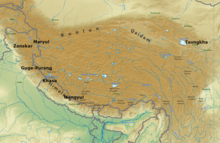Tibetan Empire
'Great Tibet'; Chinese: 吐蕃; pinyin: Tǔbō / Tǔfān) was an empire centered on the Tibetan Plateau, formed as a result of expansion under the Yarlung dynasty heralded by its 33rd king, Songtsen Gampo, in the 7th century.[8] In the opening years of the 9th century, the Tibetan Empire controlled territories extending from the Tarim Basin to the Himalayas and Bengal, and from the Pamirs into what are now the Chinese provinces of Sichuan, Gansu and Yunnan.After Rapalchen's murder, King Lang darma nearly destroyed Tibetan Buddhism[7] through his widespread targeting of Nyingma monasteries and monastic practitioners.][citation needed] Thus, for example, adherents of the Bön religion and the supporters of the ancient noble families gradually came to find themselves in competition with the "recently" introduced Tibetan Buddhism.[citation needed] The power that became the Tibetan state originated at the Taktsé Castle (Wylie: Stag-rtse) in the Chingba (Phying-ba) district of Chonggyä (Phyongs-rgyas).There, according to the Old Tibetan Chronicle, a group convinced Tagbu Nyazig (Stag-bu snya-gzigs) to rebel against Gudri Zingpoje (Dgu-gri Zing-po-rje), who was, in turn, a vassal of the Zhangzhung empire under the Lig myi dynasty.In 635-36 the Emperor attacked and defeated the Tuyuhun (Tibetan: ‘A zha), who lived around Lake Koko Nur and controlled important trade routes into China.However, when the king refused to consummate the marriage, she then helped her brother to defeat Lig myi-rhya and incorporate Zhangzhung into the Tibetan Empire.[21] The records of the Tang Annals do, however, seem to clearly place these events in the reign of Songtsen Gampo for they say that in 634, Zhangzhung and various Qiang tribes "altogether submitted to him."In the spring of 670, Tibet attacked the remaining Chinese territories in the western Tarim Basin after winning the Battle of Dafeichuan against the Tang dynasty.[29] Emperor Mangsong Mangtsen (Trimang Löntsen' or Khri-mang-slon-rtsan) married Thrimalö (Khri-ma-lod), a woman who would be of great importance in Tibetan history.(There is evidence that the Gar were descended from members of the Lesser Yuezhi, a people who had originally spoken an Indo-European language and migrated, sometime after the 3rd century BC, from Gansu or the Tarim into Kokonur.)Two years later in 698 emperor Tridu Songtsen reportedly invited the Gar clan (who numbered more than 2000 people) to a hunting party and had them massacred.The Princess Jincheng (Tibetan: Kyimshang Kongjo) arrived in 710, but it is somewhat unclear whether she married the seven-year-old Gyeltsugru[38] or the deposed Lha Balpo.In 737, the Tibetans launched an attack against the king of Bru-za (Gilgit), who asked for Chinese help, but was ultimately forced to pay homage to Tibet.In 747, the hold of Tibet was loosened by the campaign of general Gao Xianzhi, who tried to re-open the direct communications between Central Asia and Kashmir.Then Takdra Lukong (Stag-sgra Klu-khong) presented evidence to prince Song Detsen (Srong-lde-brtsan) that they were disloyal and causing dissension in the country, and were about to attack him also.From that time onward the Tibetans pressed into the territory of the Tang emperors, reaching the Chinese capital Chang'an (modern Xi'an) in late 763.[47] Recent historical research indicates the presence of Christianity in as early as the sixth and seventh centuries, a period when the Hephthalites had extensive links with the Tibetans.It also contains an account of the conquest of large swathes of northwestern China including the capture of Chang'an, the Chinese capital, for a short period in 763 CE, during the reign of Emperor Daizong.[56] Tritsu Detsen (Khri gtsug lde brtsan), best known as Ralpacan, is important to Tibetan Buddhists as one of the three Dharma Kings who brought Buddhism to Tibet.It was under the reign of Ralpacan that the political power of Tibet was at its greatest extent, stretching as far as Mongolia and Bengal, and entering into treaties with China on a mutual basis.The reign of Langdarma (Glang dar ma), regal title Tri Uidumtsaen (Khri 'U'i dum brtsan), was plagued by external troubles.The period that followed, known traditionally as the Era of Fragmentation, was dominated by rebellions against the remnants of imperial Tibet and the rise of regional warlords.The oldest armour dated from the time of the "Righteous Kings, Uncle, and Nephew" which would place it sometime during the Yarlung dynasty, early seventh to mid ninth century.[64] According to Du You (735–812) in his encyclopaedic text, the Tongdian, the Tibetans were less proficient in archery and fought in the following manner: The men and horses all wear chain mail armor.When the Turgesh attacked the Arabs, their khagan Suluk was reported to have worn Tibetan armour, which saved him from two arrows before a third penetrated his breast.They join their hands to hold wine, and make plates of felt, and knead dough into cups, which they fill with broth and cream and eat the whole together.








Tibetic languagesTibetan BuddhismGovernmentMonarchyTsenpoSongtsen GampoTrisong DetsenRalpachenU Dum TsenLönchenGar Tongtsen YülsungGar Trinring TsendroNganlam Takdra LukhongNanam Shang Gyaltsen LhanangNyang Tingngezin SangpoDranga Palkye YongtenLate AntiquityPopulationZhangzhungTuyuhunTang dynastyEra of FragmentationHistory of TibetNeolithic TibetYarlung dynastyYuan rulePhagmodrupa dynastyRinpungpa dynastyTsangpa dynastyKhoshut KhanateGanden PhodrangMing–Tibet relationsQing rule13th and 14th Dalai LamaPRC ruleTimelineHistorical moneyList of rulersEuropean explorationTibetanChinesepinyinTibetan PlateauRapalchenChang'anAfghanistanBay of BengalYarlung ValleyShol Potala Pillar821–823 treatyJokhangTarim BasinHimalayasBengalPamirsSichuanYunnanVajrayanaGuru PadmasambhavaTimeline of the Tibetan EmpireTaktsé CastleOld Tibetan ChronicleNamri SongtsenNamri LöntsänKingdom of SumpaSui dynastyBuddhismMyang MangpojeGar TongtsenKoko NurTibetan attack on SongzhouPrincess WenchengTrimang LönTang AnnalsSongzhouattacked SongzhouKhotanBattle of DafeichuanFour Garrisons of AnxiMangsong MangtsenThrimalöTridu SongtsenLesser YuezhiIndo-European languageKokonurGar Tsenye DompuGar Tridring TsendröZhou ChinaWu ZetienYangtzeNanzhaoYellow RiverFirst disseminationMe AgtsomLha BalpoPrincess JinchengUmayyad CaliphateTurgeshMuslim conquest of TransoxianaGilgitGao XianzhiKarluksBattle of TalasinterregnumAn Shi RebellionAn Lushanpuppet emperorEmperor DaizongLuoyangKyrgyzUyghursChristianityHephthalitesPatriarch Timothy ILhasa Zhol PillarPotalaMuné TsenpoMutik TsenpoBhutaneseSadnalegsAbbasid CaliphateSamarkandCaliphateMuslimKashmirTibetans